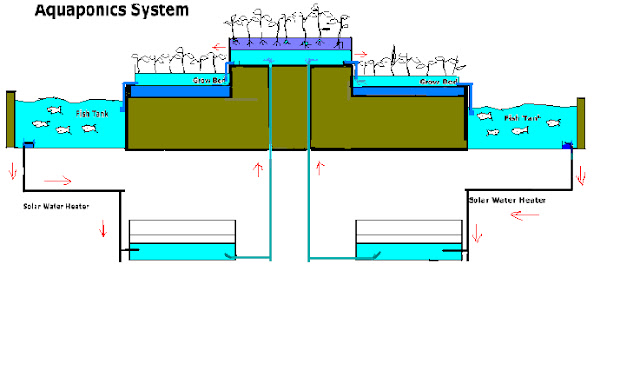Tilapia are raised in a fish tank. Air pumps keep the water moving and deliver oxygen to the fish. Water flows by gravity from the fish tank into a filter where the solid fish wastes are taken out. The liquid portion of the wastes, containing nitrogen in the form of Ammonia, flow into the growing troughs. Here bacteria convert the ammonia to nitrates which are plant fertilizers. Vegetables, planted in small baskets inserted in a Styrofoam "raft", float on the trough with their roots dangling into the water. They pull all the nitrogen out of the water as food leaving the water clean to be pumped back to the fish.
The fish wastes don't contain everything that the plants need so we have to add a few things. Calcium carbonate (crushed sea shells) are added to keep the PH correct for both the fish and plants, as well as to supplement calcium which is a critical mineral for gowning plants. Iron, Magnesium and potassium need to be supplemented as well.
As in most cases, the whole is more than the sum of the parts. Joining an aquaculture and hydroponic system creates a whole ecosystem that solves some of the major problems when
either of these two industries is operated independently.
Advantages of aquaponics:
Efficient Land Usage - Because of the efficiency in nutrient delivery to the plants in an aquaponic system, they can be planted together very densely, thus making more Efficient use of land. I've heard that the planting density is up to 5x that in the ground. Combine this with even higher density for the first half of the plants life when it is on the sprouting table and that leads to very Efficient land usage.
Water Conservation - The only water consumed is from transpiration of the plants themselves plus a little for evaporation and a few leaks that might occur. I've read that aquaponics can use as little as 1/10 the water of in ground farming
Low Labor - After the initial building of the system, it takes relatively low labor to maintain. Transplanting is effortless, weeding is minimal, and soil preparation is non existent.
Pests Deterred - Some pests are not an issue with aquaponics that would be for in ground gardening. In Hawaii specifically, wild pigs don't seem to mess with aquaponic systems, you don't have to worry about damaging nematodes that live in the ground, and rat lung worm slugs can be more easily controlled.
Drawbacks:
High initial Investment - Costs of building materials, pumps, etc is much larger than in ground gardening.
Needs constant attention - although the overall number of hours to maintain is low, it does need attention once or twice a day to feed fish, water seedlings, and to just make sure everything is operating OK. Probably only 10-15 minutes a day, but that is every day. So it's just like having a pet, you'll need someone to take care of it when you're out of town. Here is where economy of scale really comes into play....it takes just as long to feed the fish in a commercial system with thousands of square feet of gowning area as it does to feed a small home system with 10s of square feet of growing area.









